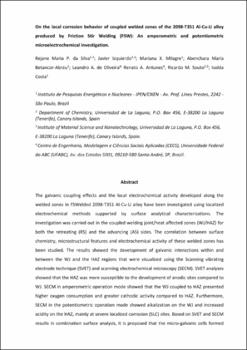On the local corrosion behavior of coupled welded zones of the 2098-T351 Al-Cu-Li alloy produced by Friction Stir Welding (FSW): An amperometric and potentiometric microelectrochemical investigation
Fecha
2021Resumen
The galvanic coupling effects and the local electrochemical activity developed along the welded zones in FSWelded 2098-T351 Al-Cu-Li alloy have been investigated using localized electrochemical methods supported by surface analytical characterizations. The investigation was carried out in the coupled welding joint/heat affected zones (WJ/HAZ) for both the retreating (RS) and the advancing (AS) sides. The correlation between surface chemistry, microstructural features and electrochemical activity of these welded zones has been studied. The results showed the development of galvanic interactions within and between the WJ and the HAZ regions that were visualized using the Scanning vibrating electrode technique (SVET) and scanning electrochemical microscopy (SECM). SVET analyses showed that the HAZ was more susceptible to the development of anodic sites compared to WJ. SECM in amperometric operation mode showed that the WJ coupled to HAZ presented higher oxygen consumption and greater cathodic activity compared to HAZ. Furthermore, SECM in the potentiometric operation mode showed alkalization on the WJ and increased acidity on the HAZ, mainly at severe localized corrosion (SLC) sites. Based on SVET and SECM results in combination surface analysis, it is proposed that the micro-galvanic cells formed
within these welded zones are due to the presence of secondary phases in the 2098-T351 alloy and their interactions with the adjacent matrix.






